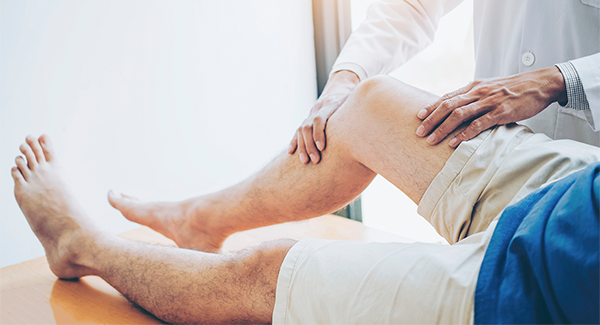16 Joint-Protection Tips
Protect your joints from added pain or injury with these 16 self-care tips.
1. 16 Joint-protection Tips
Arthritis aches and pain can affect your daily life. But there are simple ways to protect your joints, reduce strain and improve how you function each day. Here are 16 things you can do that could make a big difference.
2. Ditch the high heels.
Unless you're a fashion model, chances are you can live without high heels. Experts say a 3-inch heel stresses your foot seven times more than a 1-inch heel. In addition, heels put extra stress on your knees and may increase your risk of developing osteoarthritis.
3. Hang out at the bar.
Popular veggies from a salad bar – romaine and Bibb lettuces, broccoli, spinach, kale or parsley – can slow down cartilage destruction and lessen the amount of bone loss that occurs with age, research says, thanks to their high calcium counts. But remember to go easy on the dressing.
4. Move around.
Neither sitting nor standing on your feet all day is good for your joints. When possible, alternate between the two to prevent stiffness and strain. If your job primarily involves sitting, try to take a break and stand up every 30 minutes or so. Whether at home or the office, make time for simple stretches throughout the day.
5. Kick butt.
People who smoke have a greater risk of fracture than nonsmokers. In fact, smoking can reduce bone mass, which can lead to osteoporosis. Kick the habit to keep your body strong and healthy. Plus, just think of all the money you'll save by going smoke-free.
6. Resolve to reduce.
If you lose weight, you may not only like your “new look,” you’ll feel better, too. Every extra pound you gain puts four times the stress on your knees. The flip side is that even a small amount of weight loss will give your knees relief. Research has shown that losing as little as 11 pounds may improve your joint health and cut your risk of osteoarthritis of the knee by 50%.
7. Take the plunge.
From strength training to jogging to aerobic classes (and let’s not forget the plain old swim), aquatic exercises can help maintain flexibility and range of motion, while taking a load off of your joints while you exercise.
8. Warm up.
Don't think about hitting the gym, the pool or the trails (or any exercise for that matter) before warming up. Warming up your body before exercise is like warming your car up in the winter. To keep it running smoothly and for optimal joint safety, start slowly and get up to speed only after your muscles and joints have at least five minutes prep time.
9. Handle heavy loads with care.
Use your largest, strongest joints and muscles to take stress off of smaller hand joints and to spread the load over large surface areas. When you lift or carry items, use the palms of both hands or use your arms instead of your hands. Hold items close to your body, which is less stressful for your joints. For joint safety, slide objects whenever possible rather than lifting them.
10. Build strong bones.
Boost your calcium intake, because a diet rich in this important mineral helps to keep your bones sturdy and can lower your risk of osteoporosis, the brittle bone disease. There are plenty of sources besides milk, including yogurt, broccoli, kale, figs, salmon and calcium supplements.
11. Pick, pour or peel.
If you’re looking for a tasty treat, reach for an orange – or a tall glass of orange juice. Why? Research shows vitamin C may help to slow the progression of osteoarthritis.
12. Cut back on caffeine.
While you may need that extra burst of energy in the morning, try and resist those second and third cups of coffee. Studies show that the extra caffeine can weaken your bones.
13. Take your vitamins.
Supplementing your diet with a multivitamin is a good way to get the nutrients you may lack in your diet. Strong joints and overall joint health will benefit from bone-building calcium and vitamin K, tissue-repairing vitamin C, pain-relieving vitamin E, folic acid and more.
14. Choose function over fashion.
Shoes shouldn't just look good; they should work well, too. Look for flexible, supportive shoes that are squared or rounded at the toe so your toes can move around. A shoe with a rubber sole will give you more cushion. Make sure your shoe is flexible at the ball of your foot, where you push off, but supportive enough that you cannot bend it in half from heel to toe.
15. Don't stomp your feet.
Research shows pounding exercises like kickboxing and step aerobics can be tough on joints. Switch to low-impact activities like biking and swimming that offer the same calorie-burning benefits without the painful pounding.
16. Increase your range.
Range-of-motion exercises such as stretching are a good way to keep your muscles and ligaments flexible and strong. Add weights to your workout and you'll tone up, too.
17. Say no.
It may be tough at first, but saying no to others lets you say yes to extra time for yourself. It also frees up time to allow you to say yes to exercise, healthy eating and stress reduction – three power-packed methods of improving your health.

Stay in the Know. Live in the Yes.
Get involved with the arthritis community. Tell us a little about yourself and, based on your interests, you’ll receive emails packed with the latest information and resources to live your best life and connect with others.


